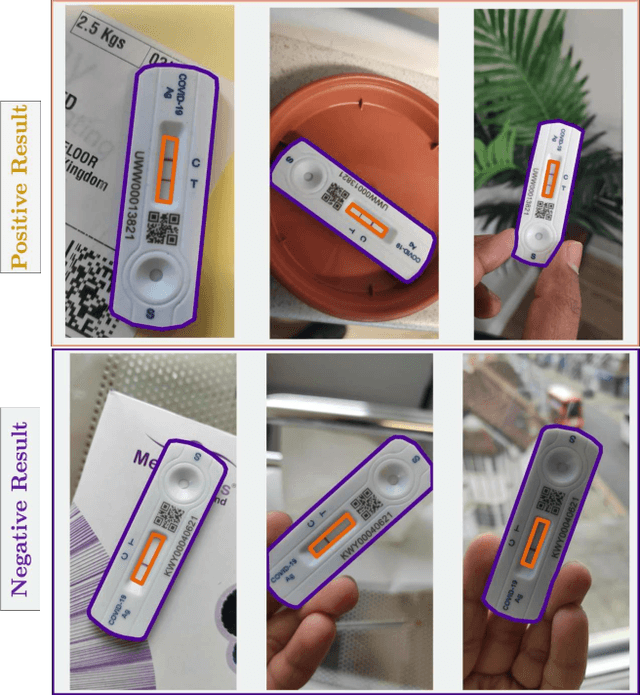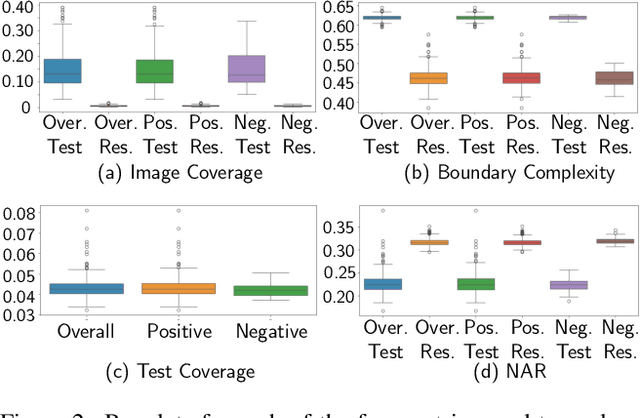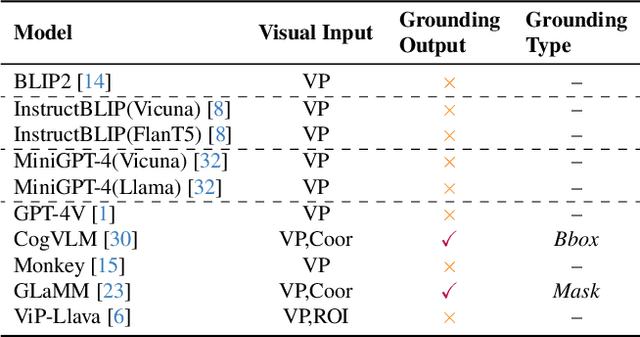Danna Gurari
PartStickers: Generating Parts of Objects for Rapid Prototyping
Apr 07, 2025Abstract:Design prototyping involves creating mockups of products or concepts to gather feedback and iterate on ideas. While prototyping often requires specific parts of objects, such as when constructing a novel creature for a video game, existing text-to-image methods tend to only generate entire objects. To address this, we propose a novel task and method of ``part sticker generation", which entails generating an isolated part of an object on a neutral background. Experiments demonstrate our method outperforms state-of-the-art baselines with respect to realism and text alignment, while preserving object-level generation capabilities. We publicly share our code and models to encourage community-wide progress on this new task: https://partsticker.github.io.
Accounting for Focus Ambiguity in Visual Questions
Jan 04, 2025



Abstract:No existing work on visual question answering explicitly accounts for ambiguity regarding where the content described in the question is located in the image. To fill this gap, we introduce VQ-FocusAmbiguity, the first VQA dataset that visually grounds each region described in the question that is necessary to arrive at the answer. We then provide an analysis showing how our dataset for visually grounding `questions' is distinct from visually grounding `answers', and characterize the properties of the questions and segmentations provided in our dataset. Finally, we benchmark modern models for two novel tasks: recognizing whether a visual question has focus ambiguity and localizing all plausible focus regions within the image. Results show that the dataset is challenging for modern models. To facilitate future progress on these tasks, we publicly share the dataset with an evaluation server at https://focusambiguity.github.io/.
Long-Form Answers to Visual Questions from Blind and Low Vision People
Aug 12, 2024



Abstract:Vision language models can now generate long-form answers to questions about images - long-form visual question answers (LFVQA). We contribute VizWiz-LF, a dataset of long-form answers to visual questions posed by blind and low vision (BLV) users. VizWiz-LF contains 4.2k long-form answers to 600 visual questions, collected from human expert describers and six VQA models. We develop and annotate functional roles of sentences of LFVQA and demonstrate that long-form answers contain information beyond the question answer such as explanations and suggestions. We further conduct automatic and human evaluations with BLV and sighted people to evaluate long-form answers. BLV people perceive both human-written and generated long-form answers to be plausible, but generated answers often hallucinate incorrect visual details, especially for unanswerable visual questions (e.g., blurry or irrelevant images). To reduce hallucinations, we evaluate the ability of VQA models to abstain from answering unanswerable questions across multiple prompting strategies.
BIV-Priv-Seg: Locating Private Content in Images Taken by People With Visual Impairments
Jul 25, 2024Abstract:Individuals who are blind or have low vision (BLV) are at a heightened risk of sharing private information if they share photographs they have taken. To facilitate developing technologies that can help preserve privacy, we introduce BIV-Priv-Seg, the first localization dataset originating from people with visual impairments that shows private content. It contains 1,028 images with segmentation annotations for 16 private object categories. We first characterize BIV-Priv-Seg and then evaluate modern models' performance for locating private content in the dataset. We find modern models struggle most with locating private objects that are not salient, small, and lack text as well as recognizing when private content is absent from an image. We facilitate future extensions by sharing our new dataset with the evaluation server at https://vizwiz.org/tasks-and-datasets/object-localization.
SPIN: Hierarchical Segmentation with Subpart Granularity in Natural Images
Jul 12, 2024Abstract:Hierarchical segmentation entails creating segmentations at varying levels of granularity. We introduce the first hierarchical semantic segmentation dataset with subpart annotations for natural images, which we call SPIN (SubPartImageNet). We also introduce two novel evaluation metrics to evaluate how well algorithms capture spatial and semantic relationships across hierarchical levels. We benchmark modern models across three different tasks and analyze their strengths and weaknesses across objects, parts, and subparts. To facilitate community-wide progress, we publicly release our dataset at https://joshmyersdean.github.io/spin/index.html.
Collecting Consistently High Quality Object Tracks with Minimal Human Involvement by Using Self-Supervised Learning to Detect Tracker Errors
May 06, 2024Abstract:We propose a hybrid framework for consistently producing high-quality object tracks by combining an automated object tracker with little human input. The key idea is to tailor a module for each dataset to intelligently decide when an object tracker is failing and so humans should be brought in to re-localize an object for continued tracking. Our approach leverages self-supervised learning on unlabeled videos to learn a tailored representation for a target object that is then used to actively monitor its tracked region and decide when the tracker fails. Since labeled data is not needed, our approach can be applied to novel object categories. Experiments on three datasets demonstrate our method outperforms existing approaches, especially for small, fast moving, or occluded objects.
Interpreting COVID Lateral Flow Tests' Results with Foundation Models
Apr 21, 2024



Abstract:Lateral flow tests (LFTs) enable rapid, low-cost testing for health conditions including Covid, pregnancy, HIV, and malaria. Automated readers of LFT results can yield many benefits including empowering blind people to independently learn about their health and accelerating data entry for large-scale monitoring (e.g., for pandemics such as Covid) by using only a single photograph per LFT test. Accordingly, we explore the abilities of modern foundation vision language models (VLMs) in interpreting such tests. To enable this analysis, we first create a new labeled dataset with hierarchical segmentations of each LFT test and its nested test result window. We call this dataset LFT-Grounding. Next, we benchmark eight modern VLMs in zero-shot settings for analyzing these images. We demonstrate that current VLMs frequently fail to correctly identify the type of LFT test, interpret the test results, locate the nested result window of the LFT tests, and recognize LFT tests when they partially obfuscated. To facilitate community-wide progress towards automated LFT reading, we publicly release our dataset at https://iamstuti.github.io/lft_grounding_foundation_models/.
Fully Authentic Visual Question Answering Dataset from Online Communities
Nov 27, 2023Abstract:Visual Question Answering (VQA) entails answering questions about images. We introduce the first VQA dataset in which all contents originate from an authentic use case. Sourced from online question answering community forums, we call it VQAonline. We then characterize our dataset and how it relates to eight other VQA datasets. Observing that answers in our dataset tend to be much longer (e.g., with a mean of 173 words) and thus incompatible with standard VQA evaluation metrics, we next analyze which of the six popular metrics for longer text evaluation align best with human judgments. We then use the best-suited metrics to evaluate six state-of-the-art vision and language foundation models on VQAonline and reveal where they struggle most. We will release the dataset soon to facilitate future extensions.
VQA Therapy: Exploring Answer Differences by Visually Grounding Answers
Aug 24, 2023Abstract:Visual question answering is a task of predicting the answer to a question about an image. Given that different people can provide different answers to a visual question, we aim to better understand why with answer groundings. We introduce the first dataset that visually grounds each unique answer to each visual question, which we call VQAAnswerTherapy. We then propose two novel problems of predicting whether a visual question has a single answer grounding and localizing all answer groundings. We benchmark modern algorithms for these novel problems to show where they succeed and struggle. The dataset and evaluation server can be found publicly at https://vizwiz.org/tasks-and-datasets/vqa-answer-therapy/.
Interactive Segmentation for Diverse Gesture Types Without Context
Jul 20, 2023Abstract:Interactive segmentation entails a human marking an image to guide how a model either creates or edits a segmentation. Our work addresses limitations of existing methods: they either only support one gesture type for marking an image (e.g., either clicks or scribbles) or require knowledge of the gesture type being employed, and require specifying whether marked regions should be included versus excluded in the final segmentation. We instead propose a simplified interactive segmentation task where a user only must mark an image, where the input can be of any gesture type without specifying the gesture type. We support this new task by introducing the first interactive segmentation dataset with multiple gesture types as well as a new evaluation metric capable of holistically evaluating interactive segmentation algorithms. We then analyze numerous interactive segmentation algorithms, including ones adapted for our novel task. While we observe promising performance overall, we also highlight areas for future improvement. To facilitate further extensions of this work, we publicly share our new dataset at https://github.com/joshmyersdean/dig.
 Add to Chrome
Add to Chrome Add to Firefox
Add to Firefox Add to Edge
Add to Edge